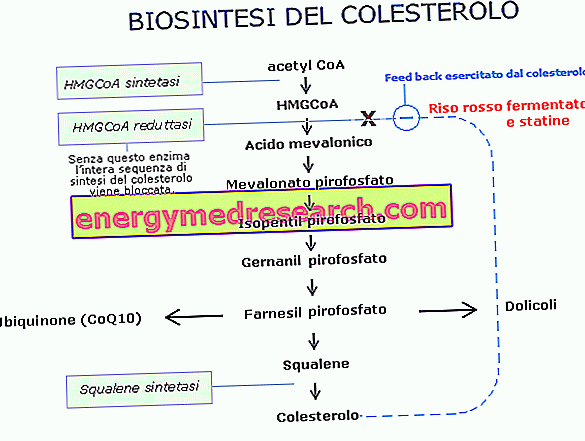Since cholesterol is a fundamental substance for life, the human organism could not depend on food intake alone. Presumably for this reason evolution has caused the body to develop an effective mechanism for cholesterol biosynthesis .
With a daily dietary intake of about 300 mg (0.3 grams), the body of an adult person synthesizes about 600-1000 mg of cholesterol every day. Liver, intestine and skin, in this sense, are the most active organs.
Considering also that not all ingested cholesterol is absorbed in the intestine (about 50% passes into the faeces), the influence of the diet on total cholesterol (concentration of cholesterol in the blood) is modest and can be estimated at 15%. Important changes in the dietary intake of cholesterol can however cause variations up to ± 30%. Food intake and endogenous synthesis are in fact strongly linked by a regulatory mechanism to feed-back, so that the endogenous synthesis is slowed down the greater the cholesterol of dietary origin, and vice versa.
The production of cholesterol in the body is the result of a complex series of reactions. It starts with the CoA vinegar derived from the metabolism of various nutrients (carbohydrates, proteins and in particular fats) to finally arrive, after about thirty reactions, to cholesterol. Among the numerous enzymes involved in this process, a major role is played by the HMG-CoA reductase, which intervenes in one of the first stages catalyzing the reduction of HMG-CoA to mevalonate. This enzyme, in fact, is characterized by an average life of only 4 hours, which is why it must be continuously synthesized in the liver. The speed with which it is produced depends on the cellular levels of cholesterol; when they are low the synthesis rate increases and vice versa. This regulatory system is particularly active in the liver, where food influence is at its maximum; in this sense the activity of the HMG-CoA reductase is inhibited by the newly formed cholesterol and by that taken by LDL.
The inhibition of this enzyme can take place not only by decreased synthesis, but also by phosphorylation by corticosteroid hormones and glucagon; insulin and thyroid hormones, on the other hand, favor dephosphorylation enhancing its activity.

Biochemical steps in detail
As shown in the figure, where the main stages of cholesterol biosynthesis are shown, some drugs (statins) and fermented red rice act as competitive inhibitors of HMG-CoA reductase and as such decrease the rate of cholesterol synthesis. As a result, the liver draws more on the blood cholesterol contained in the LDL, increasing the number of receptors for these proteins and decreasing the concentration of LDL in the plasma. However, the synthesis block is not total and this ensures that the cells have sufficient cholesterol levels to maintain the integrity of the plasma membranes and synthesize steroid hormones.



